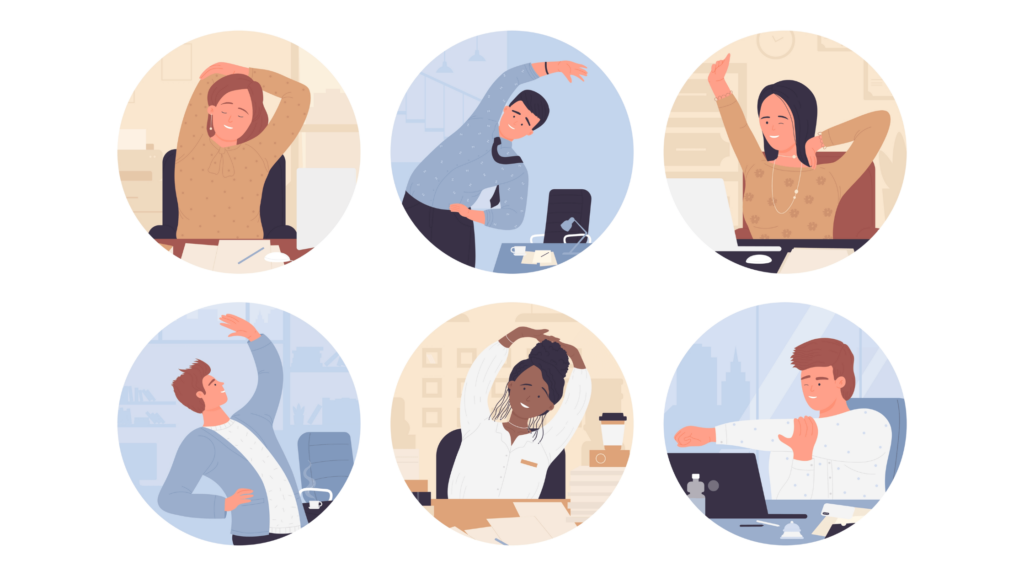Spending hours at a desk can take a toll on your body, even if you’re used to more active tasks on construction sites. Desk work may seem like a break from the physical demands of the field, but it often introduces its own challenges. One of the simplest ways to stay comfortable and avoid long-term aches is by adding simple stretches like spinal rotations and seated ankle rolls to your daily routine.
Quick look
- Sitting for long hours at a desk leads to poor posture, tight hip flexors, and reduced blood circulation, increasing the risk of chronic pain over time.
- Stretch breaks improve flexibility, boost blood flow, and relieve tension in overused muscles like the neck, shoulders, and lower back.
- Effective stretches for desk workers include neck tilts, seated spinal rotations, hamstring stretches, and chest openers.
- Incorporating just a few minutes of stretching into your workday can counteract the physical toll of prolonged sitting and keep you energized.
The problem with sitting
Sitting at a desk all day might sound harmless, but it often leads to surprising physical problems that compound over time. Poor posture is one of the biggest culprits. Focusing on a screen makes it easy to slump, round your shoulders, and crane your neck forward without noticing. Over time, this strains the muscles that support your neck and spine, leading to stiffness and discomfort.
Another common issue is tight hip flexors. Sitting for long hours shortens these muscles, which causes stiffness and may lead to lower back pain when you try to stand or move. Staying in one position for too long also slows blood circulation, leaving your legs and lower back stiff and heavy.
In the long run, these musculoskeletal issues add up. Regular desk work without movement or proper posture will contribute to muscle imbalances, reduced flexibility, and an increased risk of lower back and joint pain. Understanding these effects is the first step to managing them—and incorporating stretches into your day can make all the difference.
The importance of stretch breaks
Stretching during the workday is a simple habit that helps prevent common aches and pains caused by sitting too long. Stretch breaks allow your body to reset, improving how you feel and function throughout the day. Plus, they’re quick and easy to incorporate into your routine.
Here are some of the benefits of stretching daily for desk workers:
- Improves blood flow, delivering more oxygen and nutrients to muscles
- Relieves tension in the muscles commonly overused, such as the neck, shoulders, and wrists
- Improves flexibility of tight muscles like hip flexors and hamstrings, reducing the chances of lower back pain
- Encourages better posture by countering slumping and rounding of the shoulders
- Provides a mental reset, boosting focus and reducing fatigue
10 stretches for desk workers

Stretching while standing allows you to loosen up your body without needing equipment or a specific setup. These ten simple stretches target common problem areas for desk workers, helping you stay flexible and reduce muscle tension. Here’s how to do them:
1. Sideways neck stretch
Targeted muscles: Scalenes and upper traps
How to do it: Sit upright and gently tilt your head toward your right shoulder, bringing your ear closer to it without raising your shoulder. Hold for 30 seconds while breathing gently, letting the muscles relax, then repeat on the left side.
2. Overhead triceps stretch
Targeted muscles: Triceps
How to do it: Raise your right arm overhead and bend it at the elbow, reaching down toward your upper back. Use your left hand to push the right elbow down gently toward your left side. Hold for 30 seconds, then switch sides.
3. Seated spinal rotation
Targeted muscles: Lower back and obliques
How to do it: Sit upright with your feet flat on the floor. Place your right hand on the back of your chair and your left hand on your right knee. Twist your torso to the right, hold for 30 seconds, then switch sides.
4. Wrist and forearm stretch
Targeted muscles: Wrist flexors and extensors
How to do it: Extend your right arm forward at shoulder height, with your palm facing up or down. Use your left hand to gently pull your right hand downward until you feel a stretch. Hold for 30 seconds, then switch sides.
5. Seated hamstring stretch
Targeted muscles: Hamstrings and lower back
How to do it: Sit at the edge of your chair with one foot flat on the floor and the other leg extended straight out. Lean forward at the hips, keeping your back straight until you feel a stretch in the back of your leg. Hold for 30 seconds, then switch legs.
6. Chest opener
Targeted muscles: Chest and anterior shoulders
How to do it: Sit upright and clasp your hands behind your head. Pull your elbows back and squeeze your shoulder blades together to stretch your chest. Hold for 30 seconds.
7. Seated cat-cow stretch
Targeted muscles: Spinal extensors and lower back
How to do it: Sit with your hands on your knees. Inhale as you arch your back and look up (cow pose), then exhale as you round your back and tuck your chin to your chest (cat pose). Repeat 5 times.
8. Seated hip stretch
Targeted muscles: Hips rotators and glutes
How to do it: While seated, place your right ankle on your left knee, forming a figure-four shape. Gently press down on your right knee while leaning forward slightly. Hold for 30 seconds, then switch sides.
9. Seated ankle rolls
Targeted muscles: Ankles and calves
How to do it: Lift your right foot off the ground and rotate your ankle clockwise 10 times, then counterclockwise 10 times. Repeat with your left foot.
10. Seated side stretch
Targeted muscles: Obliques and shoulders
How to do it: Sit upright and raise your right arm overhead. Lean to the left, feeling a stretch along the right side of your body. Hold for 30 seconds, then switch sides.
Bottom line
Incorporating stretches into your daily routine will help counteract the adverse effects of sitting, improve flexibility, and energize you throughout the workday. By taking just a few minutes to stretch, you’ll reduce muscle tension, improve posture, and avoid unnecessary musculoskeletal injuries.
Looking for more tips to improve your health and productivity? Subscribe to our newsletter and follow us on social media to stay updated on practical advice, industry insights, and tools to help you thrive at work.



